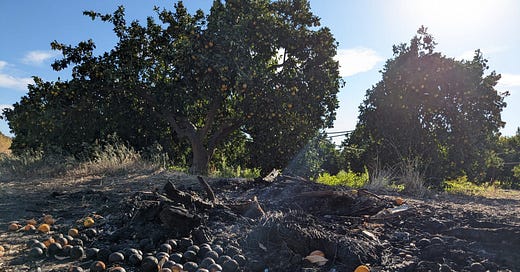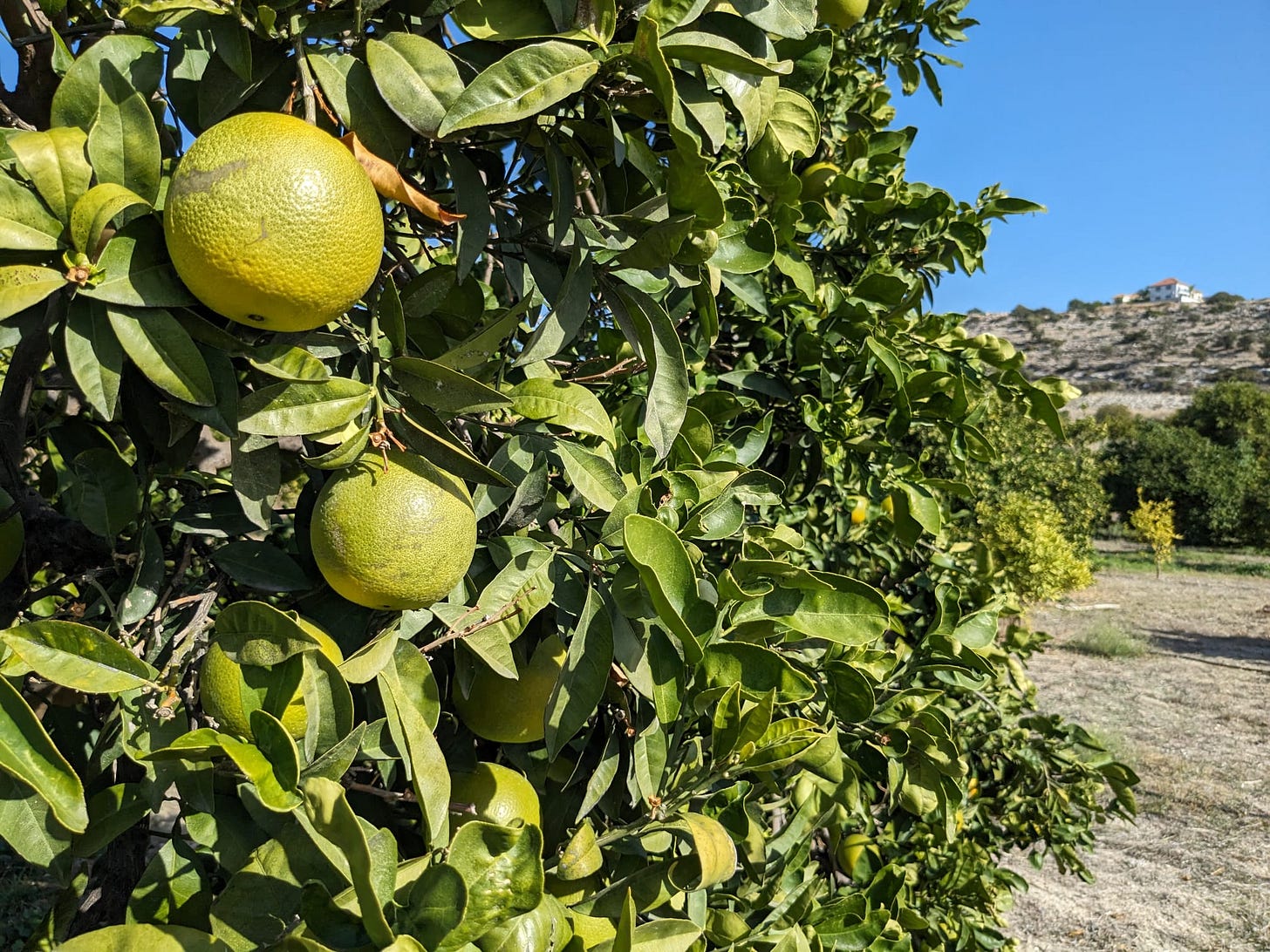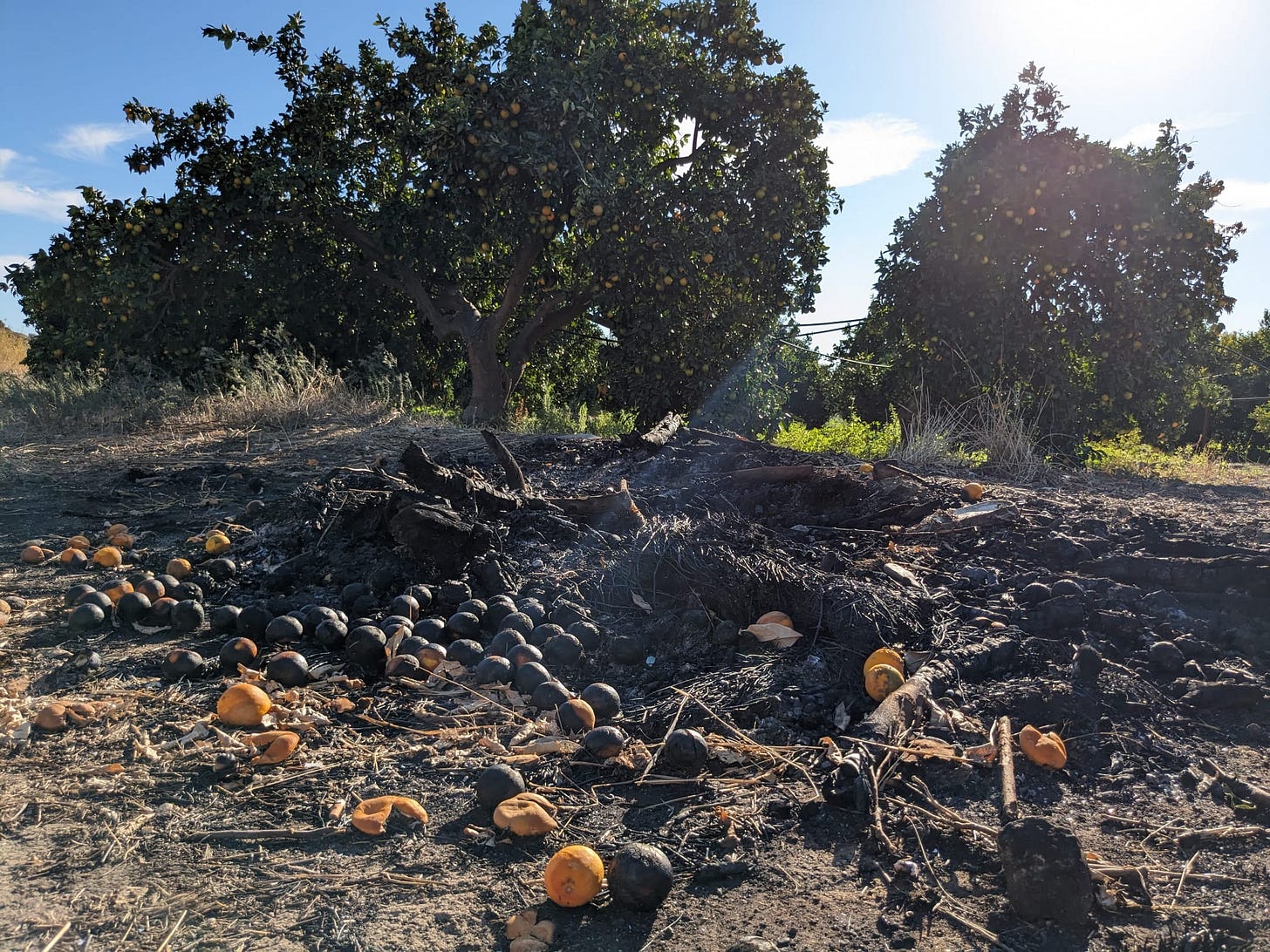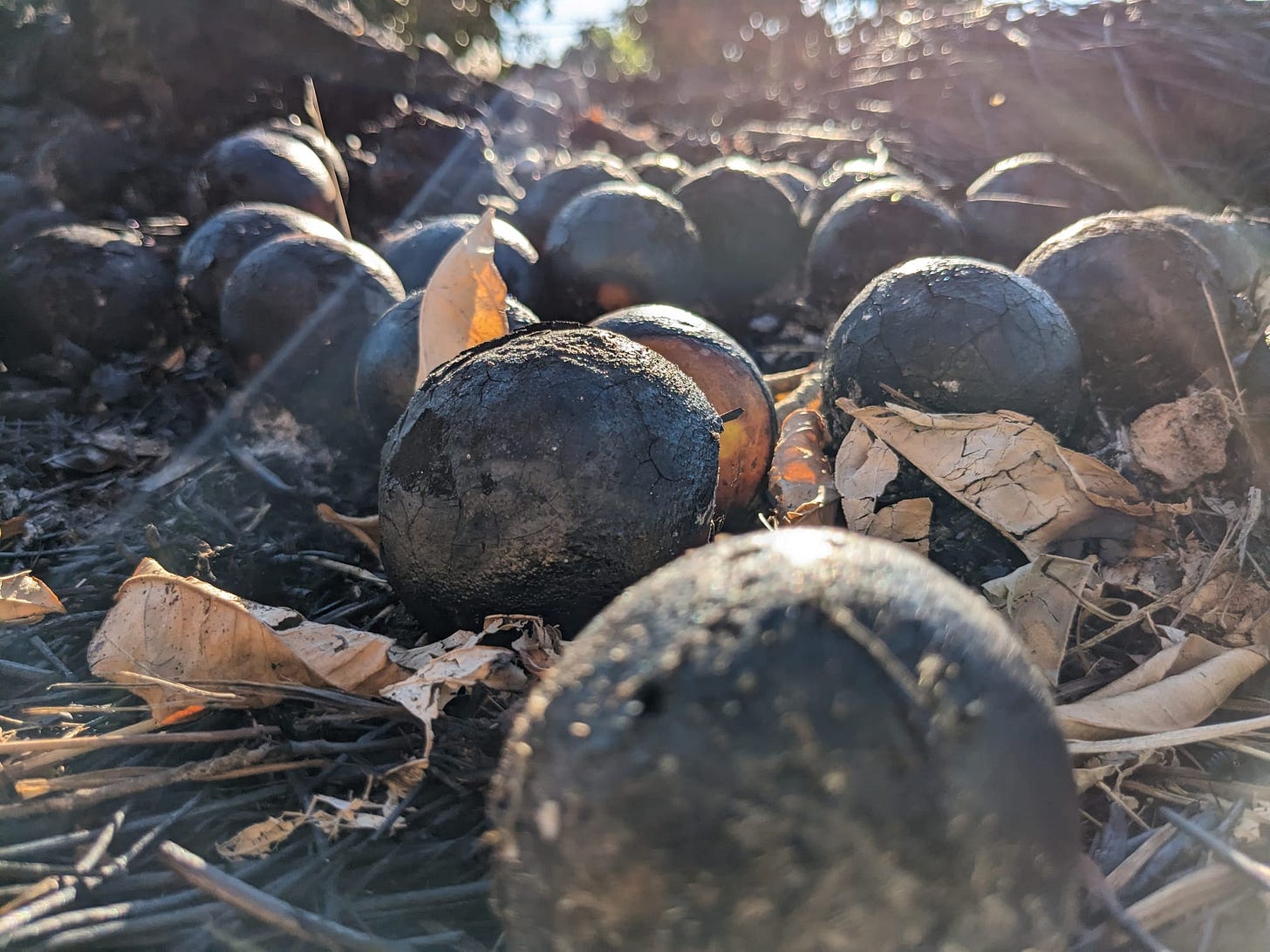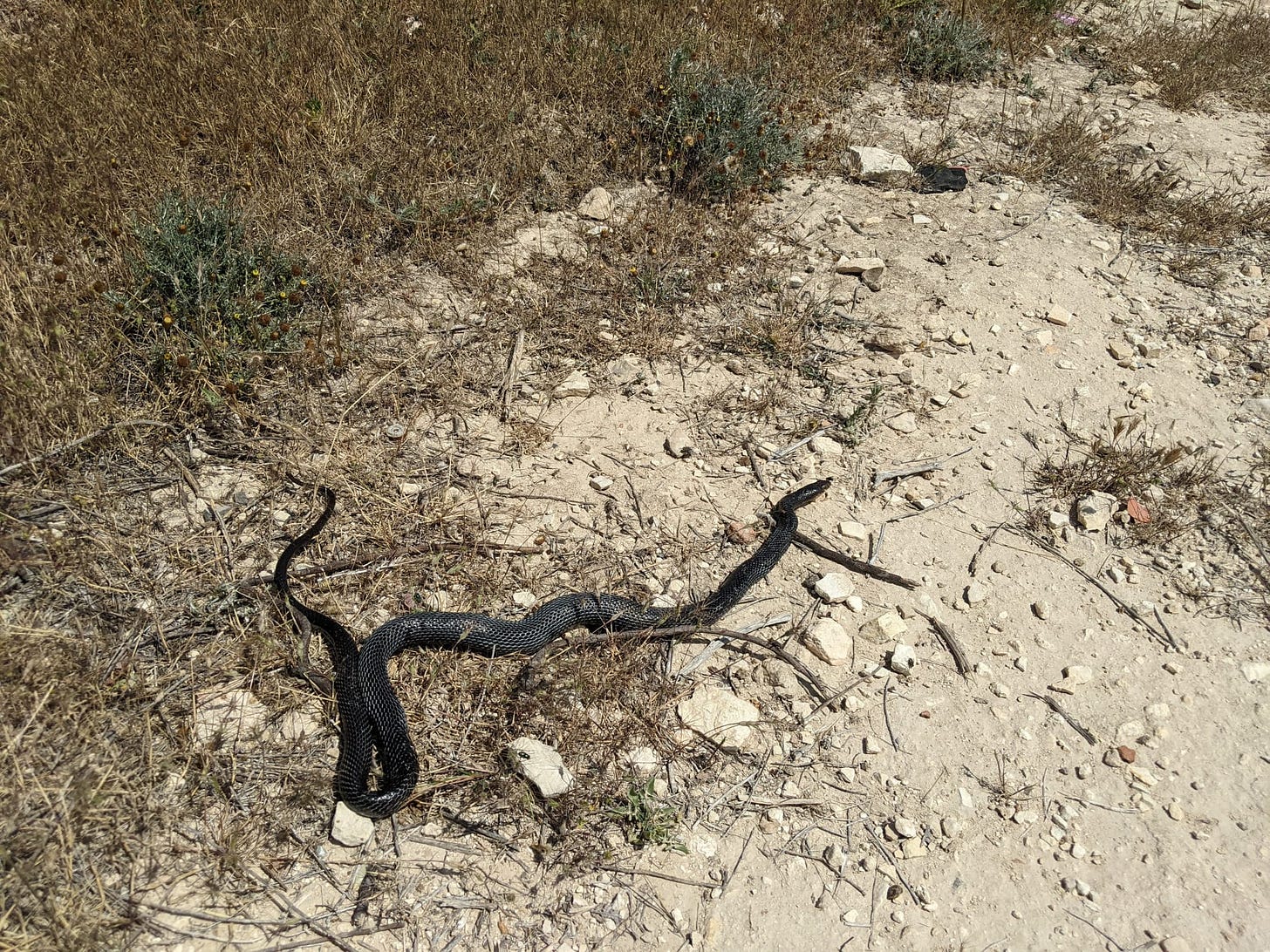Dear friends,
I’ve just got back from a jog in the valley below our house. I ran through an orange grove, where the green fruit is just beginning to flush yellow.
Around the base of each trunk is a cluster of last year’s oranges, still lying on the spot where they landed.
Coming from a damp country, I find it strange the way dead plants dry out here and hold their form. Fallen fruit has a curious longevity in this Cypriot valley, gathering, rather than turning to, dust.
For a while now I’ve been running past a tree that was cut down with last year’s oranges still on the branches. It’s made for a strange sight – looking less like a dead tree than a live tree rotated by ninety degrees.
Today I reached it and found it’s been burnt. The earth where it lay is black and strewn with incinerated oranges, which have the colour and texture of cannon balls.
What struck me most was the smell: wood smoke and bitter citrus, mixed with a sickly caramel sweetness, the terrible burnt-sugar odour of a dessert forgotten in the oven.
Amid the ashes were dozens of bleached-white snail shells. I picked one up. It had the texture of burnt paper and fell apart between my fingertips.
The black oranges, the papery shells: they felt uncanny; absurd distortions of familiar things. I stayed by the burnt tree for a few minutes intrigued by the sensory dissonance.
Uncanny moments are not uncommon in the valley, with its dried-out river and layers of fly-tipped furniture. A sofa sits in the middle of a disused quarry. A toilet protrudes from a prickly pear. A tangle of dried out branches turns out to be a mass of rusted mattress springs, a plastic tub turns out to be a fat white rock, stretches of black hosepipe litter the track where whip snakes live and sometimes the one turns out to be the other.
We’re in a stormy season now and this has generated some strange sights too. The wind was so strong recently it sent the kids’ trampoline bouncing around our back yard. There is something slightly diabolical about a trampoline jumping around on its own – it has a horror-movie strangeness.
Then last Saturday night there was a storm so spectacular I sat and watched it like a show from the balcony: impossible quantities of water lashing down on the taut, dusty ground, the wind so strong it blew the rain back upwards so that curtains of falling and rising water tussled below the beams of the streetlamps. Thunder roared and lightning flickered behind it all like a faulty strip light.
I’m not sure why I feel compelled to share those details, except that I have an intuitive sense that they fit in these letters.
Perhaps it’s because, writing about care, ecology and community, it feels important to write in and from a specific place. Paying attention to the valley where I live, trying to cultivate an ecological awareness, feels like an important part of this writing and thinking. In a time when our attention is tugged by so many remote forces, it feels refreshing to focus it on a snail or a storm or a pile of burnt oranges.
In my last letter I wrote about trees, fungi and my interest in symbiotic solutions to social challenges. Today I’d like to take this theme further and think about the relationship between social and environmental questions – and what it might mean to connect and combine them.
This enquiry comes from a personal place: I’ve held my social and environmental interests separate for much of my adult life. Now I’m making a conscious attempt to stitch them together.
I first became aware of the climate crisis as a teenager. I became vegetarian, read Thoreau and Naomi Klein and gave righteous tirades at the dinner table. When I was twenty, I started collecting newspaper clippings about global warming and biodiversity loss, amassing dozens in an overstuffed red folder. I’m not sure why I cut the pieces out of the paper. Even at the time I don’t think I knew, but it was a way of confirming and cultivating my outrage. I still have the folder in a box somewhere; one day I’d be intrigued to dig it out and see what people were saying in 2005.
As a student I got involved in climate campaigning and, after graduating, I went to the Climate Camp on a field near Heathrow Airport. An advance party occupied the site before dawn. When the rest of us arrived a few hours later, intelligence officers photographed our faces for their database. The first afternoon, while we were preparing the straw bale toilets and rocket stoves, dozens of officers stormed the field, marching towards us arm in arm. Shouts went up and the whole camp was summoned to form a wall and block the path of the police. We stood there for ten minutes, until the officers turned around and climbed back over the fence.
But after that summer of action I became a primary school teacher and moved decisively into the fields of education, care, community and inclusion, which have occupied me ever since. There was a bifurcation: I still cared deeply about the climate crisis, but I felt like my path led elsewhere. Social change was my work, I thought; other people would focus on environmental issues and I would cheer them on from the sidelines. I was confident our work pointed in the same direction, but I also felt sure it was separate.
Creating a stronger social infrastructure would make society fairer, more humane, and better able to take good decisions. That was what I would focus on – any impact on environmental crises would be indirect.
The logic of separating social and environmental questions looks questionable to me now - but that’s still how many social institutions and organisations work, operating as though social change efforts occur in isolation, as though they produce neat, self-contained outputs, rather than wide-ranging consequences that ripple through time and space, across human and more-than-human systems.
An experience that is helping me to connect social and environmental questions is my work with Moral Imaginations, an organisation who support others to create space, capacity and practices for imagining, and who believe that doing so is central to addressing our most pressing challenges.
I’ve been supporting Moral Imaginations to tell the story of their work with Camden Local Council, where they’re training ‘imagination activists’ and equipping the council to embed rich, inclusive imagining into its ways of working, both internally and with the community. Earlier this year I co-authored their Camden Imagines report with their founder Phoebe.
What I appreciate most about Moral Imaginations is the rigour of their imagining. Rigour is perhaps not a term we expect to hear in relation to imagination. But it’s essential. Without some structure, and without considering who gets to imagine as well as how, there is a risk of creating visions of the future that are flatly utopian, bypass the interconnected complexity of the world, and carry within them all manner of inequities and biases.
Moral Imaginations use the following framework to enable more rigorous, reality-based imagining, bringing three groups into their imaginative exercises:
1. Future generations (developing ideas with a long-term perspective)
2. The more-than-human world (considering the needs and interests of the more-than-human world)
3. Ancestors (bringing an attitude of historic responsibility and repair)
Although it might appear esoteric to some, this framework is simply an expression of some basic truths: that historic injustices continue to play out in the present; that human thriving depends on the thriving of the more-than-human world; and that every decision we make affects future generations. In its partnership with Moral Imaginations, Camden Council is trying to give these three parties a stake in its decisions – whether talking about housing, public spaces, social care or libraries – with the faith that doing so will lead to deeper, richer responses to local challenges.
Now that I’m attuned to this framework, it seems strange to me that any important decision would be made without regard to these three pillars. Overlooking them, or vaguely hoping for positive outcomes, risks short-term thinking that perpetuates historic injustice and damages the natural systems we depend on.
But for many years I did not find this intuitive. I’ve always been drawn to systems thinking, but I’ve tended to think primarily in terms of human systems. The work of schools, social workers, police forces all seemed remote from wider environmental crises – even those on their doorstep. And yet these institutions are all embedded into ecosystems, local and global, and it’s not difficult to imagine how conversations about community relations, a new building, a new policy, curriculum or even menu might look different if these three groups had a stake in the process.
Working with Moral Imaginations has helped wake me up to the fact that social questions are always also environmental questions – and vice versa. They affect and hinge on one another – a fact I find exciting and enabling. Those of us working in social change don’t have to see our efforts as distinct from efforts to address environmental crises; we have greater agency than we sometimes realise.
Thanks to everyone who wrote in response to my letter on symbiosis. Several people gave recommendations for further reading or listening. I’ve included them below so they’re available to everyone reading along.
Warm wishes,
Matt
Recommendations following Social Imagining # 8
· A Place of Refuge by Tobias Jones
· Radical Intimacy by Sophie K Rosa
· The Systems View of Life by Fritjof Capra and Pier Luigi Luisi
· Tristan Gooley’s courses on natural navigation
· Living Together : Searching for Community in a Fractured World by Mim Skinner
· Sara Hendren on the On Being podcast, talking about bodies and the built world
· The Overthink podcast, talking about trees
· Staying with the Trouble by Donna Haraway (as it happens, I’ve been slowly reading my way through this for the last few months and love it)

